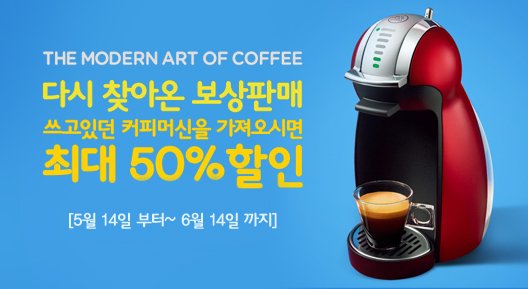This is the last Nestle journey. Today’s theme will be interesting because it contains a lot to see.
Nespresso Korea
Dolce Gusto trade-in campaign
Situation: Nestlé had obtained a patent on Nespresso for the first time in Korea in 1992, and ambitiously entered the Korea market in 2007. It was a patent of capsules production technology. But they encountered a difficult situation, both low machine distribution rate and low awareness of capsule coffee.
Meanwhile, with the expiration of Nestlé’s patent in 2012, the capsule coffee products got to boom as lots of competitors started creating their own compatible capsules and machines.
Task:
Until then, they somehow defended the competition with their patent, but from then on, they couldn’t. It was time for Nespresso Korea to make winning move to increase the sales and defend its market share, since each competitor’s capsule coffees could be compatible, or not, because those varied in size. (Capsule coffee products make profits by selling capsules rather than machines themselves.)
Action: In 2014, Nespresso Korea launched “Dolce Gusto Trade-in Campaign” to increase the penetration rate of Dolce Gusto machines. Bringing the old coffee machine to the store, you can buy a capsule coffee machine at a discount price up to 50%. Consumers could participate in this campaign with any kind of coffee machine. “Through the campaign, more than 15,000 people have bought new machines,” a company official said.

Since then, there has been regular campaigns every year for a certain period of time. Furthermore, Nespresso Korea expanded the scheme to allow consumers to purchase Dolce Gusto capsule coffee machines with up to 50% off, even if they bring not only coffee machines but also wider range of home café tools such as tumblers, mugs, coffee pots, etc. to stores.

This campaign hold at major electronic stores, hypermarkets, and department stores across the country, and consumers was able to participated in a variety of capsule coffee tasting and be instructed how to use Dolce Gusto. If bringing the used Dolce Gusto machine, consumers could buy the machine discount as well as repair the machine for free and present it to your family or friends.
Result: As a result, Nescafé Dolce Gusto coffee machines started with 5,000 units in its first launch in 2010, and sold 450,000 units in 2014, 650,000 units in 2015, and achieved 1 million units at the end of 2016, showing a remarkable growth rate. In addition, the market share of capsule coffee increased from 68% in 2015 to over 80% in 2017.
Lotte-Nestlé Korea
A career woman positioning for Taster’s Choice
In the mid-1990s, “Taster’s Choice” successfully positioned its image and established itself in the market through bold experiments. In its TV ad, a short-cut female model was highlighted and held a lot of attention. She had Western appearance, stylish clothes, confident gestures, doing business with foreigners and it featured even exotic scenery. Its target was career women, so the brand, “Taster’s Choice” wore the image of a sophisticated career woman.
After then, Nestlé appointed a top star Young-ae Lee as its model to intensify the brand image as a career woman and was on-air a series of advertisement. The advertising copy was also smart double phrases “My Seontaek, My Choice”(Seontaek in Korean means choice), which represented independent and proactive as well as contained brand names. At the same time, it tried to capture an exotic image in line with the market atmosphere of preference for foreign products.
In consequence, this strategy made Maxim, Dongsuh(a Korean native company)’s core coffee brand old-fashioned by contrasting Maxim’s consumer image with Nestlé’s. Eventually, this had a positive affect, raising Nestlé’s market share to nearly 40%.